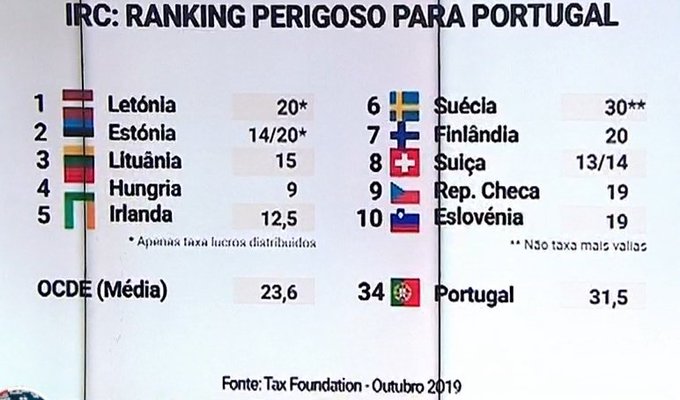Parte I e
parte II.
Começo a escrever estas linhas ao entrar no Túnel do Marão, numa viagem que me vai levar a Bragança.
Primeiro li este artigo "
Metade das empresas mais pequenas têm um gestor com o 9º ano ou menos" e fiz duas coisas:
- Publiquei isto no Twitter
- Deixei este comentário na parte II
"Deixem as empresas morrer
Bons eram os Bavas e Salgados"
Depois, comecei a ler o Jornal de Negócios de ontem (obrigado @walternatez) onde encontrei, "
Empresas Zombie empregam mais de 20% em vários setores". O que mais me surpreendeu foi ver a "doença tuga" plasmada tão abertamente:
"Concluiram que, em 2015, 6% do universo estudado eram empresas-zombies (em 2013 eram 8,5%). O número actual parece baixo, mas a melbor forma de percebrer se estas empresas estão a prejudicar a economia não é pelo seu número. Há que avaliar o seu impacto no emprego e no capital.
.
E aqui a conclusão é prcocupante: "Em Portugal as empresas-zombie são responsáveis por uma parte significativa do emprego: em alguns sectores, mais de um em cada cinco trabalhadores estão empregados numa empresa-zombie; em particular em algumas regiões, esse número aumenta para um em cada três", lê-se no artigo.
.
O estudo mostra ainda que em certos sectores estas empresas chegam a deter 25% do capital tangível, isto é, do que pode ser medido, como edifícios, máquinas, equipamentos ou outros.
.
Daí que seja preciso cuidado na forma como se gere economicamente o problema das empresas-zombies. "Potenciar a saída dessas empresas menos produtivas é certamente relevante para o funcionamento eficiente da economia, mas é neessário considerar todas as suas implicações," frisam os autores do estudo."
O último sublinhado faz-me lembrar o quão diferente analizo a situação política portuguesa versua a espanhola. Aprendi com Nassim Taleb não neste
artigo, mas em escritos mais antigos, isto:
"Why has seemingly stable Syria turned out to be the fragile regime, whereas always-in-turmoil Lebanon has so far proved robust? The answer is that prior to its civil war, Syria was exhibiting only pseudo-stability, its calm façade concealing deep structural vulnerabilities. Lebanon’s chaos, paradoxically, signaled strength."[Moi ici: O título do artigo diz tudo: "The Calm Before the Storm - Why Volatility Signals Stability, and Vice Versa"]
Esta é a "doença tuga", tão preocupados e concentrados na estabilidade como valor supremo e não conseguem ver que esta vai acumulando desequilibrios. Qunto mais tempo dura, maiores os desequilíbrios, mais dolorosa vai ser a sua correcção.
Quando se estuda a evolução da esperança de vida...
- Em Portugal em 1960 a esperança média de vida rondava os 62, 8 anos;
- Em Portugal em 2016 a esperança média de vida rondava os 81,1 anos.
Como é que se deu um ganho tão grande?
Por causa da baixa drástica da mortalidade infantil.
Ou seja, a produtividade crescerá uns cagagésimos com o esforço de melhoria nas empresas que já têm níveis de produtividade superiores e, poderá crescer muito mais com o desaparecimento das empresas-zombies.
Quando comparamos a produtividade média portuguesa com a de outros países esquecemos-nos destas empresas-zombies. Por isso, cometo o sacrilégio de apontar o dedo aos que não têm constância de propósito:
Assim, podemos acabar com esta simulação, por parte dos políticos, de preocupação com a baixa produtividade das empresas portuguesas. Aumentar a produtividade implicaria ousar deixar a economia funcionar e premiar os mais capazes.
Ter um gestor com o 9º ano não é cartão de menoridade. Afinal os primeiro-ministros e ministros das finanças que por três vezes levaram o país à falência tinham muito mais do que o 9º ano de escolaridade; afinal os banqueiros que "emprestaram" dinheiro com critérios-criativos tinham muito mais do que o 9º ano de escolaridade, afinal o
ministro da economia sabia como tratar da produtividade, afinal os cursos de gestão em Harvard e na Suíça ensinam a
aumentar a produtividade.
Tenho muito respeito pelos gestores, pelos proprietários das empresas, mesmo das empresas-zombies, gente com skin-in-the-game e que faz o melhor que pode, o melhor que sabe, o melhor que os deixam. Não tenho respeito nenhum pelos que os criticam sem skin-in-the-game, protegidos por um emprego no estado.
Tenho muito respeito pela propriedade privada.
Por isso, opto pela resposta de Popper à pergunta de Platão sobre: Quem deve governar a cidade?
A pergunta certa não é quem deve gerir as empresas. A pergunta certa é: como se facilita a morte das empresas-zombies?
BTW, a comunicação social está pejada de empresas-zombies, desde o Diário de Notícias, passando pela TSF e jornal i.



























